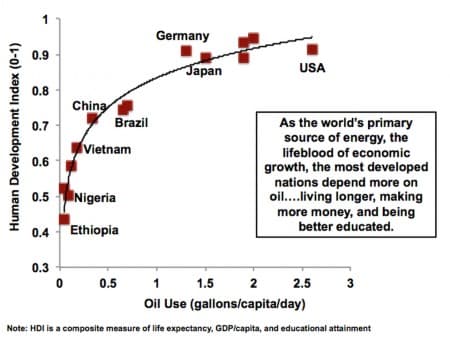Things are looking pretty good for the average American investor at the moment, with the S&P 500 still taking out new highs and a 27.3 percent YTD gain rivalled only by Russia’s RTS Index 39.2 percent return over the timeframe on the global arena.
Rising stock valuations are awesome for investors holding stocks in their portfolios--but not so great for those holding cash waiting for good entry points.
For investors who prefer to go shopping for bargains when there’s blood in the streets, the good news is that in every bull market there’s almost always a bear market tucked away somewhere.
And currently there’s no bigger bear than the energy sector.
While the tech sector continues hogging the limelight (and the dollars), the energy sector has been attracting attention for all the wrong reasons.
The tech sector has continued to shoot the lights out, totally eclipsing the energy sector, which has badly lagged almost every other sector in the US financial markets.
The tech sector’s favorite benchmark, the Technology Select Sector SPDR Fund (XLK), has climbed 45.3 percent YTD and an amazing 305 percent over the past decade.
In sharp contrast, the Energy Select Sector SPDR Fund (XLE), which has energy heavyweights ExxonMobil (NYSE:XOM) and Chevron (NYSE:CVX) as its biggest components (43.51 percent combined weighting), has only managed a mere 7 percent YTD gain and 9.3 percent over the decade.
 Related: Bullish Sentiment Keeps Oil Above $60
Related: Bullish Sentiment Keeps Oil Above $60
XLE vs. SPX 5-Year Change

Source: CNN Money
Things look even more dire when you zoom out.
Over longer timeframes, the energy sector has lagged most other sectors, returning -14 percent since June 2008.

Source: Fortune
The biggest players in the stock market now are technology companies, with Microsoft’s (NASDAQ:MSFT) $1.2T valuation bigger than the entire energy sector. Microsoft, Apple, Amazon and Facebook (NASDAQ:FB)--in that order--are the most valuable public companies.
At the same time, the top-rated energy company, ExxonMobil, dropped from the top 10 for the first time ever with its $292.9B market cap only good for 11th position.
The energy sector’s 1.5x Price-to-Book value average ranks way below the tech sector’s 8.7x and even the S&P 500’s 3.5x, meaning many stocks in the space are heavily discounted. The energy sector’s weighting in the S&P 500 has dropped to just 4 percent compared to 13 percent in 2000 while tech now commands 26 percent of the market.
Clearly, investors are not thinking very highly of energy stocks.
However, things were very different two decades ago when tech was much less dominant and diverse sectors were well represented in the top echelons. The top 4 companies in 2000 were General Electric, ExxonMobil, Pfizer and Citigroup, in that order.
Long live oil & gas
With the way things are going, it appears the tech boom is about to send oil and gas stocks into oblivion. Tech is clearly stealing the show, and even older tech companies like Microsoft and Apple have managed to find favor with the investing universe. It’s conceivable that 20 years from now, no single energy stock will even make the Top 20 in the S&P 500 Hall of Fame.
But make no mistake about it: oil and gas stocks are not dead yet, even if they’re not Hall of Famers.
Despite the obvious popularity of tech stocks and the rapid growth of renewable energy, oil and gas still have some solid catalysts behind them that will ensure they continue featuring prominently in our energy economy for decades to come. Related: Another Oil Major Bails On Marcellus Shale
First is the robust demand for fossil fuels. Oil and gas markets enjoy the rare luxury of being immune to the price elasticity of demand. As long as the global population continues to grow, demand for oil and gas will keep climbing regardless of prices. The world currently consumes 26 million b/d of gasoline and 30 million b/d of diesel fuel every single day, and those numbers will keep climbing as more and more people purchase cars, especially in the developing world. It’s a numbers game, really.
India has 4 cars to every 100 people while China has 7 for every 100 citizens, both a far cry from the 82-cars-to-100-people ratio in the United States. As more people in developing nations buy cars, the demand for oil is guaranteed to keep rising. There are 1.2 billion passenger cars with more than 98 percent of them relying on oil. This fleet is expected to exceed 3 billion by 2050, the ongoing EV revolution notwithstanding.
Oil demand has been on a constant uptrend over the past two decades save for times of severe recessions.

Source: Statista
Second, oil consumption has been a key indicator of the quality of life and is likely to remain that way in the foreseeable future. Oil remains the cornerstone of modernity with higher consumption almost synonymous with higher standards of living.
Roughly 83 percent of the world’s population currently lives in underdeveloped countries. The average person in rich countries consumes 1.6 gallons of oil products a day compared to just 0.32 gallons for a person living in a poor country. With the world now experiencing a dramatic reduction in poverty levels, you can expect oil demand to continue enjoying robust growth.

Source: Forbes
And finally, oil and gas will continue being our primary energy sources over the next couple of decades simply because we lack the capacity to ramp up renewable sources at a fast-enough clip to keep up with rapidly growing energy demand. Natural gas demand has been growing especially fast as LNG continues to replace coal as the favored fuel for electricity generation.
Natural gas has the potential to mitigate climate change. When used in power generation, natural gas emits ~50 percent less CO2 than coal and 30 percent less than oil, not to mention that it results in negligible emissions of nitrogen oxides, (NOx), mercury (Hg), sulfur dioxide (SO2), and particulates. The EIA estimates that natural gas will maintain its current 22 percent slice in the global energy market by 2040, whereas the fraction by oil+ coal combined is expected to fall quite dramatically.
Meanwhile, in a worst case scenario, the IPCC (Intergovernmental Panel for Climate Change) has demonstrated a clear and sustained role for natural gas under the ambitious 1.5° Celsius target wherein natural gas would still supply 19 percent of global energy needs by 2040, down from 22 percent currently.
By Alex Kimani for Oilprice.com
More Top Reads From Oilprice.com:
- Why Hasn’t Hydrogen Gone Mainstream?
- What Will The Average Oil Price Be In 2020?
- The 10 Most Important Oil Market Trends For 2020


















